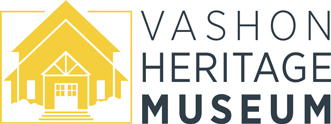By Laurie Tucker and Rayna Holtz.
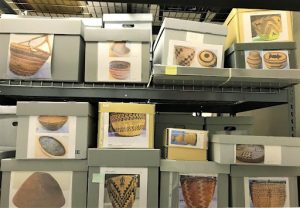 When we started this project to provide quality archival storage for the 29 Native baskets in the Vashon Heritage Museum collection it was 2017 and we had no inkling what a roller coaster ride we’d be taking! The initial training by professional museum designer and preparator Yvonne Lever was wonderful: four volunteers learned multiple techniques from her in 2018. With her assistance we went through the collection, evaluated what materials we would need, and ordered them. Then we held our first sessions to prepare storage mounts for baskets and discovered it was far trickier and more time-consuming than we’d imagined.
When we started this project to provide quality archival storage for the 29 Native baskets in the Vashon Heritage Museum collection it was 2017 and we had no inkling what a roller coaster ride we’d be taking! The initial training by professional museum designer and preparator Yvonne Lever was wonderful: four volunteers learned multiple techniques from her in 2018. With her assistance we went through the collection, evaluated what materials we would need, and ordered them. Then we held our first sessions to prepare storage mounts for baskets and discovered it was far trickier and more time-consuming than we’d imagined.
Multiple obstacles arose. Covid shut down all museum activities for almost two years. Getting back to it, we developed a team of three who found it took several sessions to complete most baskets, sometimes even more. At one point we had to reorder materials and allocate time to measure several baskets that required custom boxes with special sizes and shapes. Our original expectation that we could finish in four to six weeks (equivalent to 74 hours) turned out to be pretty naïve (we spent 433 hours)! And sadly, our efforts to communicate with Yvonne Lever over the past year have all failed, so we do not have a way to send her the compensation she deserves. Fortunately, 4Culture has had our backs, extending the grant deadlines because of the Covid interruption and the backlogs and extra work that catchup has required.
The other huge problem we had not foreseen was the amount of individual attention we would need to pay to each basket in the process of cleaning it, doing condition reports, photographing it, and taking elaborate measurements to create supports and mounts to stabilize it in its current shape.
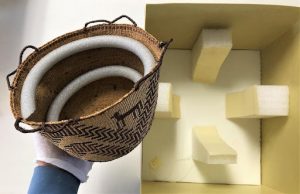 This Skokomish basket has lost its symmetry. We built individual exterior supports to stabilize it, plus we added foam coils to the interior to buoy the walls from within. Where supports contacted the basket we covered them with soft polysuede.
This Skokomish basket has lost its symmetry. We built individual exterior supports to stabilize it, plus we added foam coils to the interior to buoy the walls from within. Where supports contacted the basket we covered them with soft polysuede.
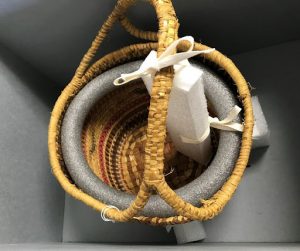 This Makah basket has a handle that has drooped and tilted, and we stabilized it in its current position with a vertical ethafoam mount lined with polysuede, and pH neutral ties. Its tall sides also needed support, so we added a coil to the inside and ethafoam mounts outside, lined with polysuede.
This Makah basket has a handle that has drooped and tilted, and we stabilized it in its current position with a vertical ethafoam mount lined with polysuede, and pH neutral ties. Its tall sides also needed support, so we added a coil to the inside and ethafoam mounts outside, lined with polysuede.
One of the most extraordinary challenges was this beautiful Coast Salish cedar hat that has a secondary cap woven inside of it to closely fit the head. We created a muslin bag filled with custom carved ethafoam for the interior cap, created foam coil supports for both its rim and the broader curve of the outside hat, and a larger carved ethafoam base (also covered by muslin) to support the sides of the large outer hat. It took two of us working together for three sessions! 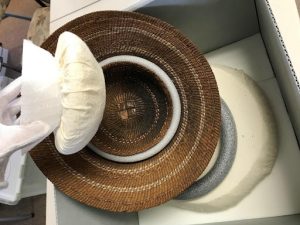
In other cases we were able to fit baskets with protective materials in single sessions. In addition to having supports to keep walls and handles from deforming, each basket is secured in its box, so that in the event of earthquake, it will remain in position and not get tossed around.
We developed great respect for the baskets and their unknown makers in the course of this long process. Weaving styles, patterns, materials, purposes, shapes and sizes of the baskets vary considerably, and illustrate both differences in local styles and the versatility of weavers in producing vessels crafted for very specific purposes. Thanks to the financial assistance offered by 4Culture, the Vashon-Maury Island Heritage Museum can now provide secure long term care for the collection and more informed programming on Native basketry.

